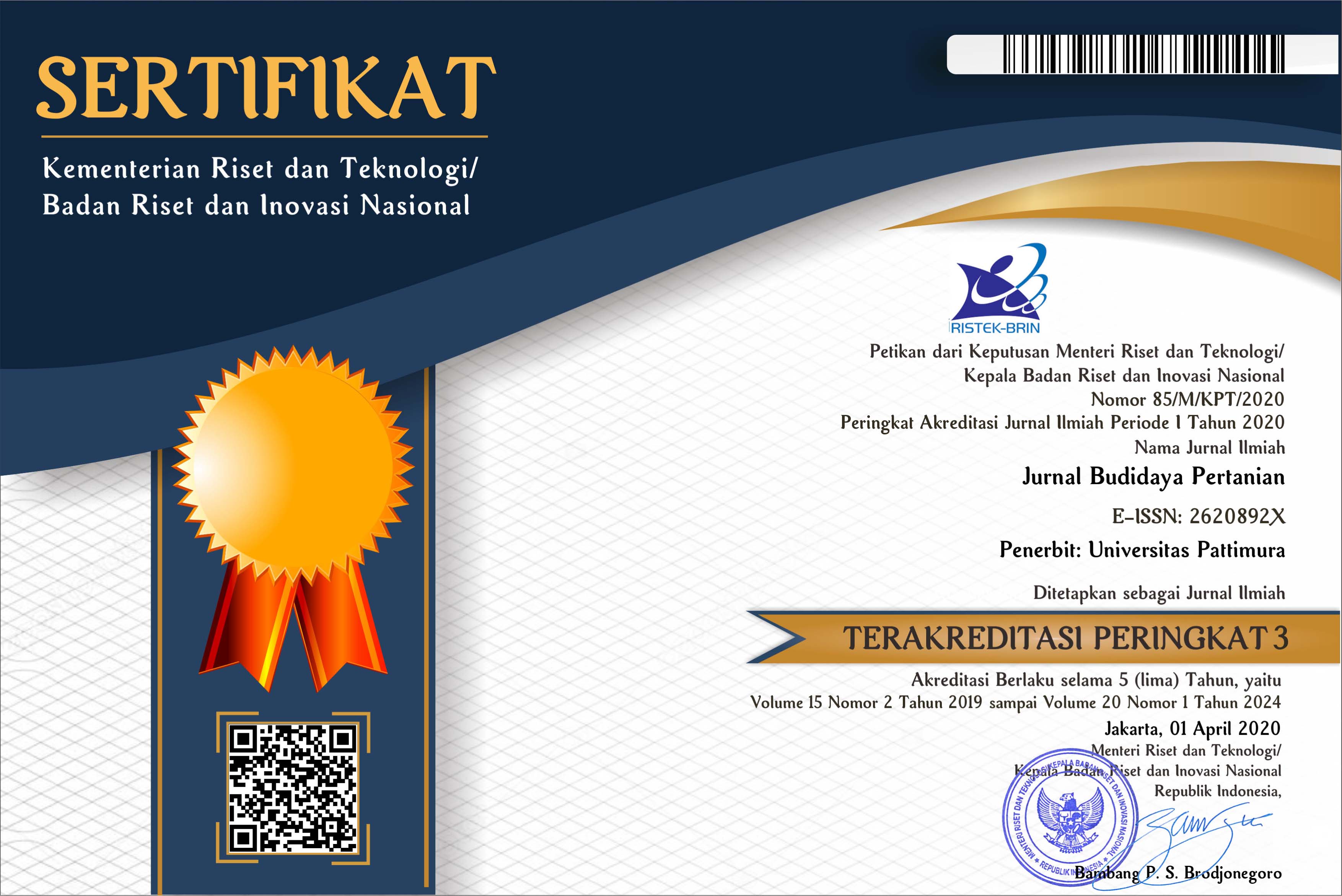Optimalisasi Citra Termal dalam Pertanian Presisi untuk Deteksi Dini Masalah Kesehatan Bibit Kelapa Sawit
Optimization of Thermal Imaging in Precision Agriculture for Early Detection of Oil Palm Seedling Health Problems
Abstract
The palm oil industry plays a pivotal role in various sectors, including food and bioenergy. The success of oil palm cultivation relies heavily on the health of the plant's seedlings. Early detection of diseases and stress is crucial to prevent a decline in crop yields and financial losses. Infrared Thermography technology has been widely employed across various fields for non-destructive monitoring, including agriculture. This research focuses on optimizing the use of thermal imaging in precision agriculture to early detect health issues in oil palm seedlings. Thermal imaging enables the precise measurement of plant surface temperatures, facilitating the identification of plant health issues without the need for further visual intervention. This study has the potential to transform approaches to proactively monitoring and managing the health of oil palm plants. Infrared thermography technology is utilized to observe temperature distribution patterns in oil palm seedlings. The objective is to explore the correlation between thermal characteristics and potential health issues or symptoms in these seedlings. Samples used in the research involve Tenera variety oil palm seedlings aged between 5-9 months, a critical growth phase. The study employs the UNI-T UTi120 Mobile thermal camera capable of measuring temperatures ranging from -20°C to 400°C. Subsequently, thermal image processing is conducted to identify thermal characteristics that could serve as indicators of health issues in oil palm seedlings. Statistical analysis is then performed to test significant differences in thermal characteristics between healthy and unhealthy plant samples. The analysis results reveal significant temperature variations between healthy and unhealthy portions of the plant seedlings, with a significance value of 0,025. These findings can serve as a basis for identifying temperature changes as potential early indicators of health issues in oil palm seedlings. This provides a foundation for developing more effective precision agriculture approaches within the palm oil industry.
Downloads
References
Alimin. (2022). Dampak Perubahan Iklim Terhadap Perkembangan Organisme Pengganggu Tumbuhan (OPT) Tanaman Perkebunan. Kementerian Pertanian Direktorat Jenderal Perkebunan. https://ditjenbun.pertanian.go.id/dampak-perubahan-iklim-terhadap-perkembangan-organisme-pengganggu-tumbuhan-opt-tanaman-perkebunan/
Asra, R., Samarlina, R. A., & Silalahi, M. (2020). Hormon Tumbuhan (I. Jatmoko, Ed.; 1st ed.). UKI Press. http://repository.uki.ac.id/
Fauziah, W. K. (2021). Evaluasi Non Destruktif Kualitas Tandan Buah Segar (TBS) Kelapa Sawit (Elaeis guineensis Jack) Berdasarkan Sifat Termal. (Tesis). Universitas Andalas.
Fauziah, W. K., Makky, M., Santosa, & Cherie, D. (2021). Thermal vision of oil palm fruits under difference ripeness quality. IOP Conference Series: Earth and Environmental Science, 644(1). https://doi.org/10.1088/1755-1315/644/1/012044
Maryani, A. T. (2012). 1807-Article Text-3548-1-10-20141023. Jurnal Online Universitas Jambi, 1(2), 64–74. https://online-journal.unja.ac.id/
Mastuti, R. (2016). Modul Metabolit Sekunder dan Pertahanan Tanaman. Universitas Brawijaya. pp. 1–18.
Megavitry, R., Dinata, G. F., Sutiharni, Suanda, I. W., Dirmawati, S. R., Thamrin, N. T., Syarifuddin, R. N., Fitriana, A., Killa, Y. M., Hariyanto, B., & Aksan, M. (2023). Perlindungan tanaman (M. Sari & T. P. Wahyu, Eds.; 1st ed.). PT GLOBAL EKSEKUTIF TEKNOLOGI.
Mouazen, A. M., Saeys, W., Xing, J., De Baerdemaeker, J., & Ramon, H. (2005). Near infrared spectroscopy for agricultural materials: An instrument comparison. Journal of Near Infrared Spectroscopy, 13(2), 87–97. https://doi.org/10.1255/jnirs.461
Savitri, E. S., Minarno, E. B., & Resmisari, R. S. (2015). Karakter Molekuler Kedelai (Glycine max) Toleran Kekeringan Hasil Induksi Mutasi dengan Mutagen EMS (Ethyl Methane Salfonanate). 1–75.
Sipayung, T. (2023). Perkebunan Sawit Rakyat Indonesia : Perkembangan, Kontribusi dan Tantangan (2023). PASPI. https://palmoilina.asia/sawit-hub/perkembangan-perkebunan-sawit-rakyat/
Copyright (c) 2023 Melidawati Melidawati, Imam Sofi’i, W K Fauziah

This work is licensed under a Creative Commons Attribution-ShareAlike 4.0 International License.

 Accreditation is valid for 5 years, starting from Volume 15 Issues 2 December 2019 up to Volume 20 Issue 1 June 2024.
Accreditation is valid for 5 years, starting from Volume 15 Issues 2 December 2019 up to Volume 20 Issue 1 June 2024.






